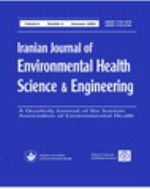
|
Iranian Journal of Environmental Health, Science and Engineering
Iranian Association of Environmental Health (IAEH)
ISSN: 1735-1979
Vol. 7, No. 3, 2010, pp. 319-326
|
 Bioline Code: se10037
Bioline Code: se10037
Full paper language: English
Document type: Research Article
Document available free of charge
|
|
|
Iranian Journal of Environmental Health, Science and Engineering, Vol. 7, No. 3, 2010, pp. 319-326
| en |
Bioremediation; Fertilizer; Heterotrophic bacteria; Crude oil; Normal paraffin
Chorom, M.; Sharifi, H.S. & Motamedi, H.
Abstract
Oil pollution is a worldwide threat to the environment and the remediation of oil-contaminated soils, sediments and water is a major challenge for environmental research. Bioremediation is a useful method for soil remediation, if pollutant concentrations are moderate and non-biological techniques are not economical. The bioremediation consists strategy of actively aerating the soils and adding fertilizer in order to promote oil biodegradation by indigenous microorganisms. The objective of this study was to investigate whether agricultural fertilizers (N, P, K) enhance the microbial degradation of petroleum hydrocarbons in soil. Artificially polluted soil with %1 density of crude oil was used and then fertilizers were applied in 3 levels of 0, 1 and 2 ton/ha in 3 replicates. The soils were kept in 30 ºC and 60 percent of field capacity condition for 5 to 10 weeks. To provide the necessary aeration, the soils were tilled twice a week by shovel. Soil sample were analyzed for hydrocarbon-degrading heterophic bacteria count and some soil chemical properties. Residual oil was measured by oil soxhlet extraction method, and gas chromatography. The results showed that the hydrocarbon-degrading and heterotrophic bacteria count in all the treatments increased with time and heterotrophic bacteria population increased from 6×103 cfu/g soil to 1.4×108 cfu/g soil. Also, soil C/N ratio decreased from 6 to 3. The results indicated that the applied fertilizer increased the degradation of the hydrocarbons compared with the control. Gas chromatography results showed that normal paraffin and isopernoid (Phitane and Pristane) decreased in the range of 45 to 60 percent in all treatments. Furthermore, the results showed that the application of fertilizers at 2 ton/ha rate in oil-contaminated soil lead to greater rates of biodegradation after 5 weeks indicating the feasibility of bioremediation
Keywords
Bioremediation Of A Crude Oil - Polluted Soil By Application Of Fertilizers
|
| |
© Copyright 2010 Iran Journal of EnvironHealth Sci Eng.
Alternative site location: http://diglib.tums.ac.ir/pub/
|
|
